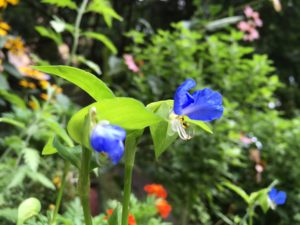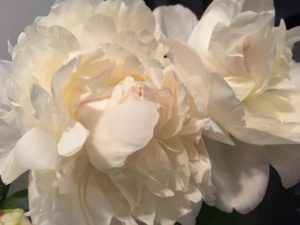
I went to the garden after the rain. The tiny blue petals of dayflowers seemed more resplendent than usual. Their vines and leaves spread on the grounds, stretching beyond the edge of the terrace. Considered “noxious” and “invasive” by many, they are welcome guests in my garden.
I first encountered these small jewels when I was in high school. One day I saw a patch of dayflowers sprawled along a ditch on the roadside. The color of the flowers caught my eyes. I was also amused by the smallness of them.
Our school was in the suburb of Taipei on a hill near the National Palace Museum. Every year, as courtesy, we were invited to visit the Museum. There, I found dayflowers on a handscroll among other “auspicious” species: peonies, lotus, hydrangea, magnolia, and the like. I was mesmerized by the vividness of the image. At the same time, the irony of roadside weeds becoming a treasure and being displayed at a Museum also didn’t escape me. There is only a thin line between arts and reality.
When I began building a garden on our terrace a few years ago, I was surprised to see dayflowers popping up at one corner. Effortlessly they connected my parallel lives on two sides of the ocean; my past and present. I saw myself standing in the gallery, fixating at the painted flowers.
I love flowers. Watching them fade and wither away saddens me. I am not good at keeping their images with paint brushes. I was good at making silk flowers in my teen years: cutting leaves and petals out of ribbons; bending them by hand or pressing them with hot iron; and wrapping them onto wires. Petal by petal; leaf by leaf; stem by stem; beautiful flowers would grow out my hands. The exuberant dyes made them more vivacious then the real ones.
I loved making peonies. They were flowers that I only read in classic literature. They were flowers that I only saw in paintings and photos. With ribbons, I could bring them into reality. Out of my fingers, amazing things happened.

These days, I grew peonies in my garden: classical crimson ones and pale pink “Mrs. F. D Roosevelt.” In late spring, the buds gradually grow rounder and fuller. As they quietly unwrap, gentle fragrances fill the air. And, I know that they will come back year after year.
“Ma i fior ch’io faccio, ahimè!
Non hanno odore. . .”
“But the flowers that I make, alas!
Don’t have fragrance. . .”
Mimì in Puccini, La Bohème, Act 1
YouTube: “A Collection of Spring Fortune” 春祺集錦 by Wang Chengpei 汪承霈, Qing dynasty.
The brocade handscroll mentioned in the post is housed in the National Palace Museum in Taipei.
